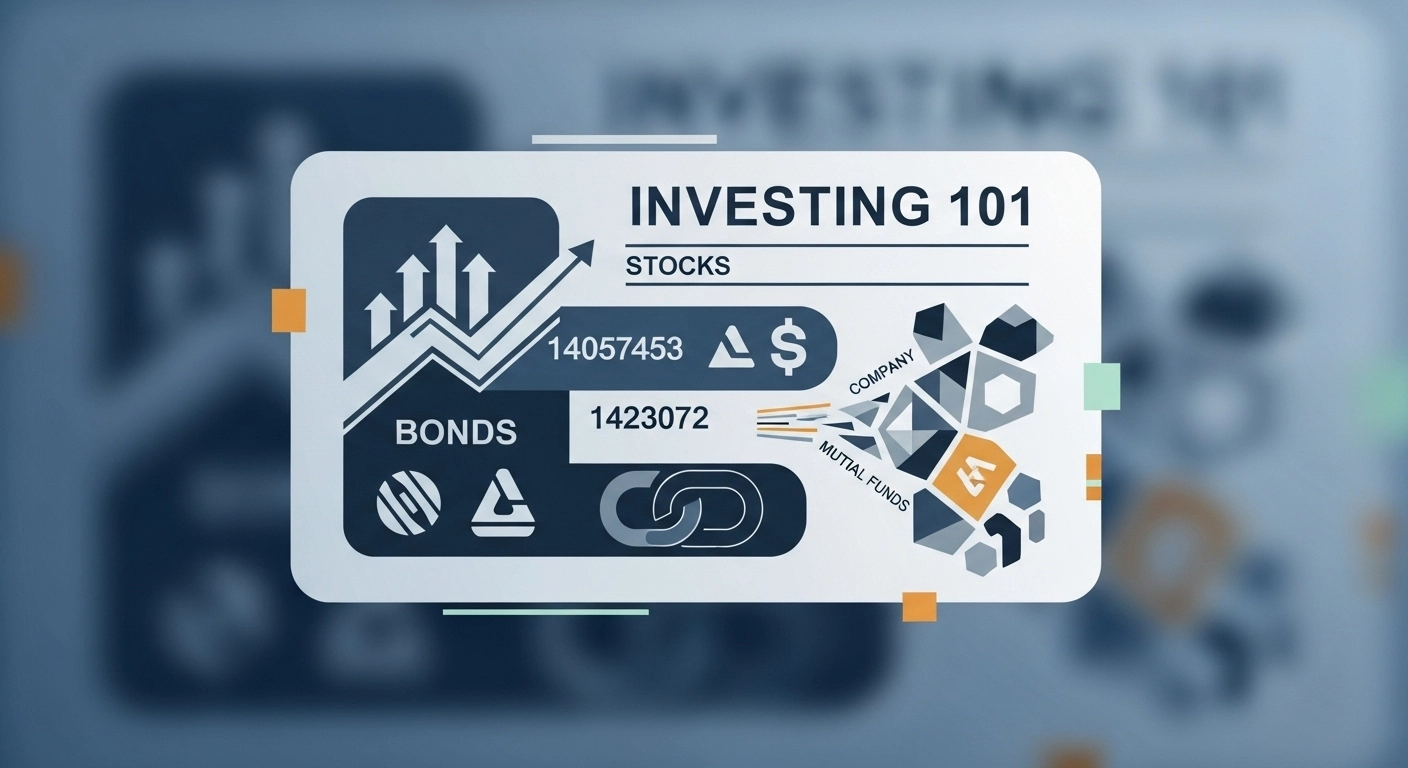Investing is an essential tool for building long-term wealth. While saving involves setting money aside, investing puts your money to work, giving it the potential to grow significantly over time. This guide will break down the fundamental investment vehicles, stocks, bonds, and mutual funds, in simple terms to help you start your journey.
The Basics of Investing
At its core, investing is the act of allocating money with the expectation of a future return. It’s the difference between letting your money sit idle in a savings account and actively trying to make it grow. The fundamental concept to understand is the relationship between risk and reward. Generally, the higher the potential for reward, the higher the risk you take.
Another critical factor is your time horizon, which is how long you plan to invest. The longer your time horizon, the more time your investments have to recover from market downturns and benefit from compounding growth. Compounding occurs when the earnings from an investment also start earning money, resulting in exponential growth over time. It’s often called the “eighth wonder of the world” for a reason.
What Are Stocks?
A stock represents a small piece of ownership in a public company. When you buy a share of stock, you become a part-owner, or shareholder, of that company. Investors make money from stocks in two primary ways:
- Capital Gains: This is the profit you make when you sell your stock for a higher price than you bought it.
- Dividends: Some companies share a portion of their profits with shareholders in the form of regular payments called dividends.
Benefits and Risks
The main benefit of stocks is their high growth potential. Historically, the stock market has provided some of the highest long-term returns compared to other asset classes. However, this potential comes with risks, primarily volatility.
The value of stocks can fluctuate wildly due to market downturns or poor company performance, meaning you could lose money. For example, if you bought Apple stock at $150 and it grew to $200, you’d have a capital gain of $50 per share. But if it dropped to $100, you would have a loss.
What Are Bonds?
A bond is essentially an IOU where you, the investor, are lending money to a borrower, typically a corporation or government entity, for a set period. In return, the borrower promises to pay you back the original amount (the principal) on a specific date (the maturity date) while also paying you regular interest payments.
Benefits and Risks
Bonds are generally considered a safer investment than stocks, offering a more stable and predictable income stream. They are often used to balance a portfolio, as they tend to be less volatile during market downturns. For instance, U.S. Treasury bonds are often referred to as “safe haven” investments because they are backed by the full faith and credit of the U.S. government.
However, bonds have their own set of risks. The returns are typically lower than what you’d expect from stocks. They’re also subject to interest rate risk (if interest rates rise, the value of existing bonds may fall) and inflation risk, where the purchasing power of your fixed interest payments is eroded by rising prices.
What Are Mutual Funds?
A mutual fund is a professionally managed investment fund that pools money from many investors to purchase securities like stocks, bonds, money market instruments, and other assets. When you invest in a mutual fund, you buy shares of the fund itself, which represents a proportional ownership in the fund’s diversified portfolio. Instead of owning individual stocks, you own a slice of a large, pre-made basket of investments.
Benefits and Risks
The biggest advantage of mutual funds is diversification. By investing in one fund, you’re instantly spreading your money across many securities, which can help mitigate risk. They also offer professional management, as a fund manager makes the buy and sell decisions. This can make them an easier starting point for beginners.
However, mutual funds aren’t without risk. The main drawback is that they charge management fees, known as the expense ratio, which can eat into your returns over time. While they’re diversified, the value of a mutual fund is still tied to the market, so you can lose money if the underlying investments perform poorly.
They also offer less control; you can’t choose which individual stocks or bonds the fund holds. The Securities and Exchange Commission (SEC) offers a guide to understanding the basics of stocks, bonds, and mutual funds.
Types of Mutual Funds
Mutual funds are categorized by the assets they hold and their investment strategy. The main types include:
- Stock funds: These funds invest primarily in a variety of stocks. They can be further broken down by company size (small-cap, mid-cap, large-cap) or by industry (technology, healthcare, etc.).
- Bond funds: Also known as fixed-income funds, they invest in a portfolio of bonds. These funds are generally less volatile than stock funds and aim to provide steady income.
- Balanced funds: These funds hold a mix of both stocks and bonds to provide a balance of growth and income.
- Index funds: A type of passively managed fund that aims to replicate the performance of a specific market index, such as the S&P 500. Because they aren’t actively managed, they typically have lower fees. An S&P 500 index fund, for example, would own shares of the 500 companies in that index in the same proportion.
Benefits and Risks
The biggest advantage of mutual funds is diversification. By investing in one fund, you’re instantly spreading your money across many securities, which can help mitigate risk. They also offer professional management, as a fund manager makes the buy and sell decisions. This can make them an easier starting point for beginners.
However, mutual funds aren’t without risk. The main drawback is that they charge management fees, known as the expense ratio, which can eat into your returns over time. While they’re diversified, the value of a mutual fund is still tied to the market, so you can lose money if the underlying investments perform poorly. They also offer less control; you can’t choose which individual stocks or bonds the fund holds.
Comparing Stocks, Bonds, and Mutual Funds
The best investment strategy for you will likely include a mix of these assets. Here’s a simple comparison to help you understand their roles.
| Feature | Stocks | Bonds | Mutual Funds |
| Definition | Ownership in a single company | A loan to a company or government | A professionally managed pool of money from many investors |
| Risk | High (can be very volatile) | Lower (safer, less volatile) | Varies by fund, generally lower than a single stock due to diversification |
| Return | High growth potential | Lower, steady income | Varies by fund, from low to high potential based on holdings |
| Accessibility | Easy to buy and sell individually | Can be bought individually or through funds | Very accessible, often with low minimum investments |
| Best For | Aggressive, long-term growth, and investors are comfortable with high risk | Capital preservation, generating income, and balancing a portfolio | Diversification, professional management, and beginners |
A balanced portfolio often uses these investments together. Younger investors with a long time horizon might have a higher allocation to stocks for growth, with a smaller portion in bonds. As you get closer to retirement, you might shift your portfolio to a higher percentage of bonds and mutual funds for stability and income. Mutual funds are an excellent way to easily achieve this diversification, regardless of your age or risk tolerance.
How to Start Investing: A Step-by-Step Guide
Starting your investment journey can seem daunting, but breaking it down into a few simple steps makes it manageable.
- Set Your Financial Goals: Before you invest a single dollar, define what you’re saving for. Is it a down payment on a house, retirement, or a new car? Your goals will determine your timeline and risk tolerance.
- Build Your Emergency Fund First: This is the most critical step. Before investing, ensure you have 3-6 months of living expenses saved in a high-yield savings account. This fund is your safety net, preventing you from having to sell investments at a loss if an unexpected expense arises.
- Open a Brokerage Account or Use a Robo-Advisor: A brokerage account (with companies like Charles Schwab, Fidelity, or Vanguard) is where you’ll buy and sell investments. If you’re new, a robo-advisor (like Betterment or Wealthfront) can be an excellent option. They use algorithms to build and manage a diversified portfolio for you based on your goals, often for a low fee.
- Start Small and Stay Consistent: You don’t need to be rich to start investing. With a concept called dollar-cost averaging, you invest a fixed amount of money at regular intervals (e.g., $50 every two weeks). This strategy reduces risk by averaging out your purchase price over time. Consider starting with low-cost ETFs or mutual funds to gain instant diversification.
- Keep Learning and Avoid Common Mistakes: The best investors are perpetual learners. Educate yourself on the companies or funds you own. Most importantly, avoid common pitfalls like emotional trading (making impulsive decisions based on fear or greed) and chasing trends (jumping into the latest hot stock without understanding it).
FAQs About Beginner Investing
Here are answers to some of the most common questions from new investors.
How Much Money Do I Need to Start Investing?
You can start with as little as $0 to $100. Many online brokerages have eliminated account minimums, and platforms allow you to buy fractional shares of expensive stocks, making investing accessible to everyone.
What’s Safer: Stocks, Bonds, or Mutual Funds?
Generally, bonds are considered the safest for capital preservation, while stocks carry the most risk but offer the highest potential for long-term growth. Mutual funds fall somewhere in the middle, as they are diversified, which reduces the risk of owning a single security. You can learn more about investing fundamentals, including key terms and concepts, by visiting FINRA’s Investing Basics page.
Are Mutual Funds and ETFs the Same Thing?
No, but they are very similar. Both are pooled investment vehicles. The key difference is how they trade. ETFs (Exchange Traded Funds) trade on an exchange throughout the day like a stock, while mutual funds are priced only once per day after the market closes.
Can I Lose All My Money in Stocks or Funds?
With an individual stock, the company can go bankrupt, causing the stock to become worthless. However, with a diversified mutual fund, it’s extremely unlikely you will lose everything, as the fund is spread across hundreds of different companies and industries.
Should Beginners Pick Stocks Directly or Start With Funds?
Most financial experts recommend that beginners start with diversified mutual funds or ETFs. These products provide broad market exposure and a level of safety that picking individual stocks cannot, which is a highly challenging and time-consuming endeavor.
What’s the Difference Between Active and Passive Investing?
Active investing involves a fund manager who actively buys and sells securities in an attempt to beat a market index. This often results in higher fees. Passive investing involves buying and holding a portfolio that tracks a market index, such as the S&P 500. This approach has lower fees and has historically outperformed most actively managed funds over the long run.
Conclusion: Your Patient Path to Wealth
Investing doesn’t have to be intimidating. By understanding the core concepts of stocks, bonds, and mutual funds, you can begin to build a solid foundation for your financial future. Stocks offer high growth potential but come with volatility. Bonds provide stability and steady income, crucial for a balanced portfolio.
Mutual funds offer an easy, diversified starting point. The key to successful investing isn’t a quick win. It’s about patience and consistency. Start small, keep learning, and trust in the power of compounding to build wealth over time.




